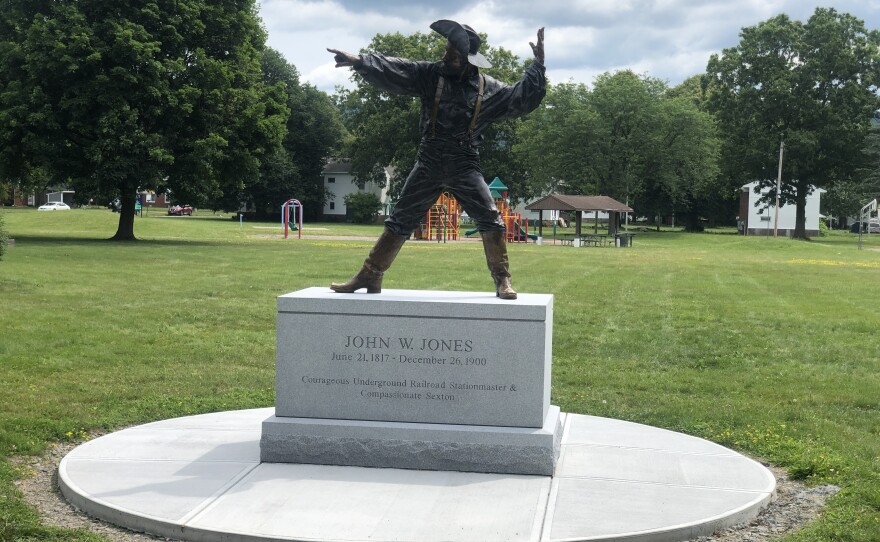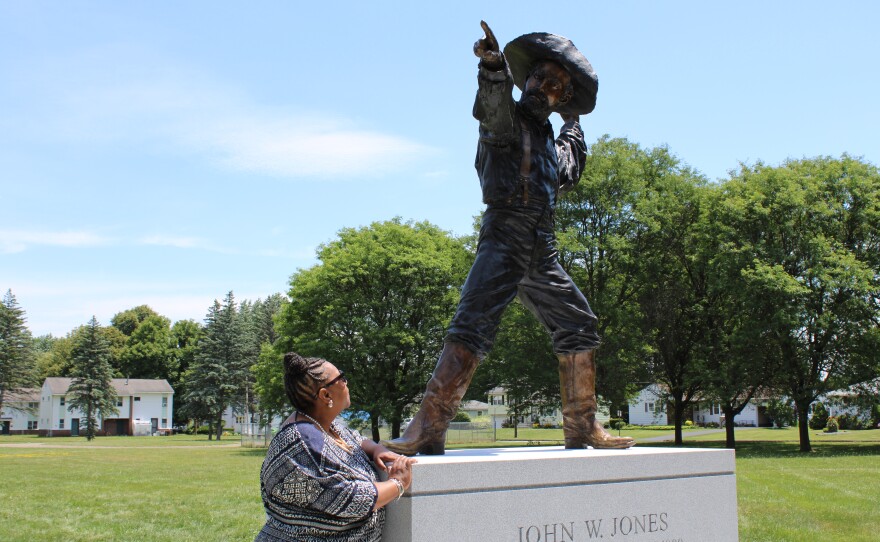The John W. Jones Museum in Elmira now has a statue of Jones, a formerly enslaved person who played a part in the Underground Railroad.
WSKG’s Natalie Abruzzo spoke with Talima Aaron, the president of the board of trustees for the museum.
This interview has been edited for length and clarity.
______________________________________________________________
NATALIE ABRUZZO, HOST: John W. Jones escaped slavery in Virginia and made his way to New York.
In the years that followed, he helped secure the safe passage of other enslaved people from Pennsylvania through Elmira and up to St. Catharines, Ontario, Canada.
By keeping meticulous records of the names of Confederate soldiers buried at Woodlawn Cemetery, Jones contributed to the site’s designation as a national cemetery.
Today, his home is open to the public as a museum because of the work of its founder, Lucy Brown.
ABRUZZO: Who was John W. Jones?
AARON: John W. Jones was a compassionate steward. He was a sexton. The first Sexton of the Woodlawn Cemetery, and responsible for interring 2,973 Confederate soldiers that died in the Elmira prison camp. But he did it in such a way, with such respect and with such compassion, that we have a national cemetery because of his records. John Jones was an enslaved person. His forced labor camp was in Leesburg, Virginia. He escaped in 1844. He fled with his two half brothers and two gentlemen from another plantation. They walked approximately 300 miles catching a ride for the last few.
He got to Elmira, July 5, 1844, at the age of 27 with $1, less than $1.60 in his pocket, immediately started working. The job that he had, that sustained over 40 years, was being the steward of the First Baptist Church. He was so passionate about ending slavery and working in that abolitionist movement, he became the central figure for Elmira for the Underground Railroad. So he was a courageous station master of the Underground Railroad for nine years prior to the Civil War. According to an interview, he felt he saved 800 plus people.
ABRUZZO: Tell me more about his significance to Elmira, New York.
AARON: It speaks of uncovering parts of history that need to be shared. At this time where we're still finding out different things about our history and the contributions of many and all John Jones represents, of course, he represents his own contributions. But in Elmira, it says a lot about what we value as a society. So we have this diverse voice. And when I think about it, you know, it almost didn't happen, right? Because the house was about to be demolished, and John Jones was honored in 1950 where they named the first housing project after him. Well, recently, it was sold and it was renamed. So essentially, in a few years, nobody would have remembered who he was or what he did, until we, Lucy [Brown] saved this house and started the museum.
I build on that legacy by trying to elevate the story and get it out there. Our focus is to get it into the school system, so the young people learn as part, just as a normal part of the education, because Black history, American history, the same. So our contributions, like others, like Native Americans, like people who immigrated, we contributed greatly to the evolution of this country. African Americans essentially built the country. We were the economy for such a long time, i.e., the Civil War, that to not have a voice in that same history is, is negligent. We want to tell the whole story. We want everyone's voices to be heard. Just recently, as you saw, we put in a statue. This is huge. It is a beautiful work of art. It is a tribute that will not easily be erased, to a great American hero.
ABRUZZO: So you did just mention that there's [the] new statue. Tell our listeners about this new work of art that is adorning the lawn outside of the John W. Jones museum now.
AARON: This statue represents not only John Jones, the man. It's not only a tribute and an honor for him, it represents Elmira's respect for all voices in history. I was asked by a reporter during the conflicts with Charlottesville and all of the statuary and all of the discussions there, how I felt about the Confederate statue in our, the National Cemetery. And I looked at the cemetery, but I never really studied it, or, you know, went in and really, really looked around. So after a meeting, a friend and I went over, and I actually walked the space, and I was like, Oh, this is, this is beautiful. You know, the graves are laid out just the way John Jones left it. The government had used his records to map this National Cemetery, so the only thing they did was replace his wooden headstones with the granite markers that are there today. But it's with the information that John Jones had captured.
The person I was with, she says, ‘and here's the tribute to John Jones’, and I'm looking, and it's, I have to look down. There's a rock on the ground, on the rock there's a plaque, and it's from the daughters of the Confederacy, and it's very complimentary, thanking John Jones, because recognizing that without him, this would not happen. And at first I was sad. And then immediately I was angry, because I said, you know, this man is not a footnote in this history. He's not a sidebar, he's not [an] 'oh, and also.' He's the reason that you have a national cemetery. He deserves a statue. That's when I made the decision. I said he's got to have a statue. And that was in July of 2020.
Two weeks later, I get a call from a past trustee who's a great supporter, and not just of the John W. Jones museum, but all things historic in Elmira. And her name is Kay Newberry, I'm just going to shout her out. And she was like, Talima, I think John Jones needs to have a statue. And I said, funny, you should say that this is like a sign to me, this needs to happen. And she introduced me to Gary Weisman, who was the sculptor, and away we went. Gary was the absolute right person for this project. He really captured the spirit. Because if you see the statue, it's in motion, and John Jones is very much a verb. He is in action. He looks like he could just walk off that block.
ABRUZZO: Thank you so much for sitting with me today and talking about this project that you've endured and taken on and persevered with throughout the years.
AARON: Thank you, Natalie. I appreciate the opportunity to elevate Mr. Jones and to share his story with your listeners.
The statue was unveiled for the public in June. In order to prevent any obstruction of the museum itself, the statue was placed away from the museum and faces Davis Street.
The pathway to the statue remains unfinished. The museum has a brick project for public contributions for each brick. The bricks will then create the pathway from the sidewalk to the new statue of Jones. Details and information can be found on the museum’s website.





